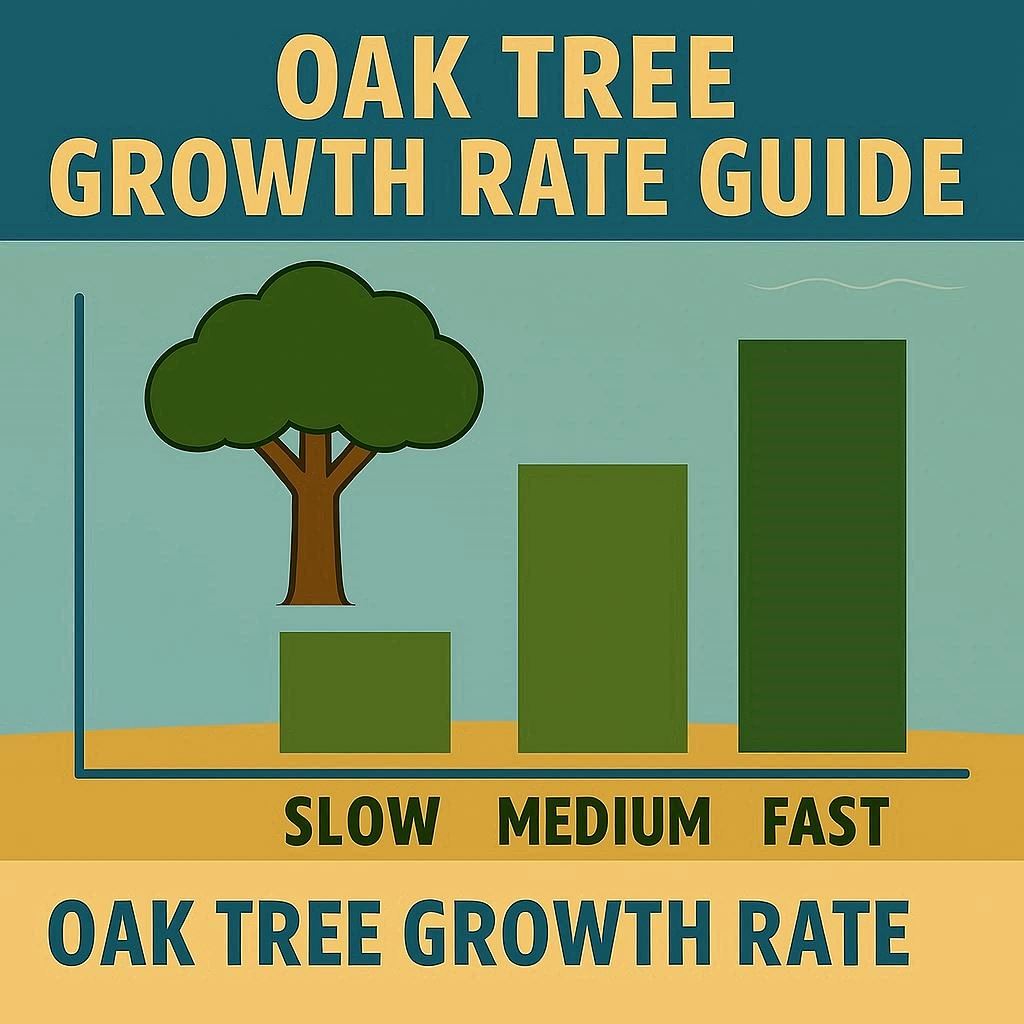
Oak trees are among the most iconic and enduring trees in the world. Known for their strength, longevity, and beauty, oaks are a favorite choice for homeowners, landscapers, and wildlife lovers alike. But one of the most common questions people ask before planting an oak is:
“How fast do oak trees grow?”
The answer depends on the species, growing conditions, and local climate. In this detailed guide, we’ll break down oak tree growth rates by species, show you a growth rate comparison chart, and give you tips on how to help your oak grow faster and healthier.
🌱 Understanding Oak Tree Growth Rate
The term growth rate refers to how much height and trunk diameter a tree gains annually. Oaks are generally moderate to slow growers, though some species can grow quite fast under the right conditions.
- Slow-growing oaks: Less than 1 foot per year
- Moderate-growing oaks: Around 1–2 feet per year
- Fast-growing oaks: Over 2 feet per year
While oaks take years to reach full maturity, many species establish quickly and provide shade, beauty, and habitat long before that.
📊 Oak Tree Growth Rate Chart (By Species)
Here’s a detailed comparison chart showing how different oak species grow under ideal conditions:
| Oak Species | Growth Rate (per year) | Mature Height | Mature Spread | Growth Type | Notable Traits |
|---|---|---|---|---|---|
| Northern Red Oak (Quercus rubra) | 2–3 ft/year | 60–75 ft | 45–50 ft | Fast | Adaptable, great shade tree |
| White Oak (Quercus alba) | 1–2 ft/year | 70–100 ft | 50–90 ft | Moderate | Long-lived (300+ years) |
| Pin Oak (Quercus palustris) | 2–3 ft/year | 60–70 ft | 25–45 ft | Fast | Thrives in wet soils |
| Bur Oak (Quercus macrocarpa) | 1–2 ft/year | 70–80 ft | 60–80 ft | Moderate | Drought-tolerant, large acorns |
| Live Oak (Quercus virginiana) | 1–2 ft/year | 40–80 ft | 60–100 ft | Moderate | Evergreen in warm climates |
| Shumard Oak (Quercus shumardii) | 2–3 ft/year | 60–80 ft | 40–60 ft | Fast | Tolerates urban environments |
| Swamp White Oak (Quercus bicolor) | 1.5–2.5 ft/year | 50–70 ft | 50–70 ft | Moderate | Thrives in wet soils |
| Southern Red Oak (Quercus falcata) | 2–3 ft/year | 60–80 ft | 50–70 ft | Fast | Excellent for southern climates |
| Nuttall Oak (Quercus texana) | 2–4 ft/year | 60–80 ft | 40–60 ft | Very Fast | One of the fastest-growing oaks |
| Overcup Oak (Quercus lyrata) | 1–2 ft/year | 45–70 ft | 40–60 ft | Moderate | Great for flood-prone areas |
| Willow Oak (Quercus phellos) | 2–3 ft/year | 60–75 ft | 40–60 ft | Fast | Narrow leaves, urban-tolerant |
| Post Oak (Quercus stellata) | 0.5–1 ft/year | 35–50 ft | 35–50 ft | Slow | Drought-tolerant, tough wood |
| Black Oak (Quercus velutina) | 1–2 ft/year | 50–60 ft | 50–60 ft | Moderate | Prefers dry, sandy soils |
| Chestnut Oak (Quercus montana) | 0.5–1 ft/year | 50–70 ft | 40–60 ft | Slow | Grows well on rocky hillsides |
| Water Oak (Quercus nigra) | 2–3 ft/year | 50–80 ft | 50–80 ft | Fast | Adapts well to southern heat |
🌳 Fastest-Growing Oak Trees
If you’re looking for quick shade or a faster noise barrier, consider these fast-growing oak species:
- Nuttall Oak – One of the fastest-growing, gaining up to 4 feet annually. Great for parks and large yards.
- Pin Oak – Commonly used in urban and suburban landscapes; rapid vertical growth.
- Southern Red Oak – Performs well in hot, humid climates; grows 2–3 feet per year.
- Shumard Oak – Thrives in city environments and adapts to various soil conditions.
- Willow Oak – Narrow leaves, fast growth, and easy to maintain; ideal for southern U.S.
These oaks establish quickly and provide dense canopies in just a few years—perfect if you want results sooner rather than later.
🌤️ Factors Affecting Oak Tree Growth Rate
Not all oak trees grow at the same pace. The following factors play a major role in determining how quickly an oak matures:
1. Species
Each oak species has unique genetics that influence growth. Nuttall and Pin Oaks grow faster, while White and Post Oaks grow slower but live longer.
2. Soil Type
Oaks prefer well-draining, loamy soils rich in organic matter. Poor, compacted, or waterlogged soil slows root development.
3. Sunlight
Full sun is crucial. Oak trees need at least 6–8 hours of direct sunlight daily for optimal photosynthesis and steady growth.
4. Water Availability
Regular watering during early years helps establish a strong root system. Mature oaks are often drought-tolerant.
5. Climate
Most oaks thrive in temperate climates. Cold winters or extreme drought can temporarily slow their annual growth rate.
6. Competition
Nearby trees, thick grass, or invasive weeds can compete for nutrients and water, stunting oak growth.
7. Age
Young oak trees grow faster (especially in the first 10–20 years). Growth slows as they mature and invest more in trunk diameter than height.
🌿 How to Make Oak Trees Grow Faster
Although oaks naturally grow at moderate rates, you can encourage faster, healthier growth with proper care.
🌞 1. Choose the Right Site
Select a location with full sun exposure and ample space for roots and canopy spread. Avoid planting too close to buildings or driveways.
💧 2. Water Regularly (But Don’t Overwater)
During the first 3 years, water deeply once a week—especially during dry spells. Mature oaks rarely need supplemental watering unless in drought.
🌾 3. Use Mulch
Apply 2–3 inches of organic mulch around the base (but not touching the trunk). This helps retain moisture, regulate soil temperature, and prevent weeds.
🌱 4. Fertilize Wisely
Oaks typically don’t require heavy fertilization, but a slow-release, low-nitrogen fertilizer in early spring can help young trees grow faster.
✂️ 5. Prune Properly
Prune dead or crossing branches during dormancy to promote better air circulation and structural growth. Avoid over-pruning young trees.
🪴 6. Avoid Lawn Competition
Grass roots compete with young oaks for nutrients. Keep a 3–4 ft grass-free zone around the base.
🐛 7. Watch for Pests and Diseases
Common issues include oak wilt, aphids, and caterpillars. Inspect regularly and treat early with eco-friendly controls if needed.
🪵 Growth Timeline: What to Expect
Here’s a general timeline of oak tree growth stages:
| Age (Years) | Height Range | Growth Phase Description |
|---|---|---|
| 0–3 years | 1–3 ft | Establishing roots; minimal top growth |
| 4–10 years | 10–25 ft | Rapid juvenile growth; trunk thickening begins |
| 10–20 years | 25–50 ft | Fastest growth phase; dense canopy forms |
| 20–50 years | 50–70 ft | Growth slows; focus on trunk diameter |
| 50+ years | 70–100 ft+ | Mature oak; height stabilizes, longevity phase |
Most oak trees reach full height in 50–100 years, though they continue strengthening and widening for centuries.
🍂 Oak Tree Lifespan vs. Growth Rate
While fast-growing trees like Nuttall and Pin Oaks provide shade quickly, slower-growing species like White and Bur Oaks often live much longer—some even surpass 300–500 years.
Fast growers = shorter lifespan
Slow growers = longer lifespan, denser wood
If you want both speed and longevity, species like Shumard Oak or Swamp White Oak offer a balanced choice.
🌰 Environmental Benefits of Growing Oaks
Regardless of their growth rate, oaks are ecological powerhouses. Planting one can benefit your yard and the planet for generations:
- Air purification: Absorb CO₂ and pollutants
- Wildlife support: Provide food (acorns) and shelter for hundreds of species
- Erosion control: Deep roots stabilize soil
- Shade and cooling: Reduce energy costs by up to 30%
- Aesthetic value: Grand, beautiful canopies increase property value
🌎 Best Oak Species by Region (U.S. Examples)
| Region | Recommended Oak Species |
|---|---|
| Northeast | Northern Red Oak, White Oak, Swamp White Oak |
| Southeast | Live Oak, Southern Red Oak, Water Oak |
| Midwest | Bur Oak, Pin Oak, Shumard Oak |
| Southwest | Nuttall Oak, Overcup Oak, Live Oak |
| West Coast | Valley Oak, Interior Live Oak, Blue Oak |
Selecting a species native to your region ensures faster establishment, disease resistance, and optimal growth.
🌲 Oak Tree Growth Rate vs Other Shade Trees
| Tree Type | Growth Rate (ft/year) | Notes |
|---|---|---|
| Oak (average) | 1–3 ft | Long-lived, strong wood |
| Maple | 2–4 ft | Faster, but shorter lifespan |
| Elm | 3–5 ft | Fast-growing, less durable |
| Birch | 1–2 ft | Shorter lifespan, decorative bark |
| Poplar | 4–6 ft | Very fast, weak wood |
| Pine | 1–3 ft | Evergreen, moderate speed |
While some trees outpace oaks early on, few match their strength, beauty, and lifespan.
🌼 Key Takeaways
- Most oaks grow 1–3 feet per year, depending on species and environment.
- Fastest-growing: Nuttall Oak, Pin Oak, Shumard Oak, Southern Red Oak, and Willow Oak.
- Longest-living: White Oak, Bur Oak, and Live Oak.
- Proper soil, sunlight, and care can accelerate growth significantly.
- Even slow-growing oaks become magnificent, durable trees that enhance your landscape for generations.
🌳 Final Thoughts
If you’re looking for a tree that combines beauty, resilience, and legacy, the oak tree is unmatched. While some species take decades to mature, every inch of growth adds to its strength and grace.
Whether you choose a fast-growing Nuttall Oak for quick shade or a slow, majestic White Oak for a lifelong landmark, your effort will be rewarded with timeless elegance and ecological benefits.
Plant an oak today — and you’ll leave behind a living monument that can stand tall for centuries. 🌰🌿
